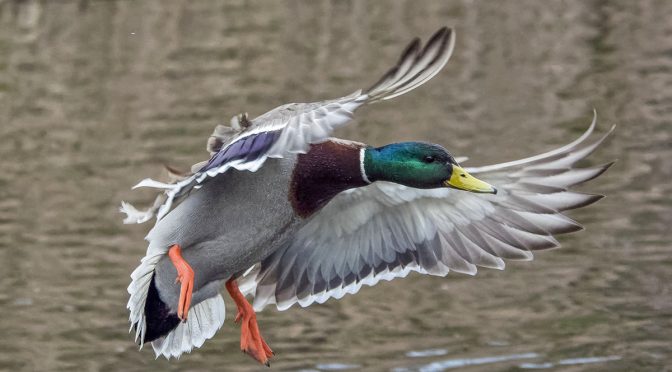This short article features a selection of photographs of an Irish mallard in-flight. These were captured during our photography field trip to Ireland in the spring of 2019. While the main objective of our trip was to capture landscape and rural images, I took a Nikon 1 V3 fitted with a 1 Nikkor CX 70-300 mm f/4.5-5.6 with me just in case I had the opportunity to photograph some wildlife.
While at Ross Castle we were treated to a mallard flying in to land on a small, marshy inlet. All I had time to do was wheel around, grab focus and fire off some AF-C images. My trusty Nikon 1 V3 was up to the task.
Since the buffer on my Nikon 1 V3 is limited to 40 images I sometimes take a short AF-C burst as a bird approaches, then use most of my buffer as the bird is in closer to me. This was the case at Ross Castle.
NOTE: Click on images to enlarge.
Let’s have a look at four consecutive images from my initial AF-C run. Having the mallard make its approach with its beak open was a bonus.




As you can see in this initial AF-C image run there often aren’t a lot of differences in wing positions in the early stages of a bird’s approach. This is another reason why I only take a short initial AF-C burst. I’d rather use up my buffer capturing more interesting in-flight wing positions.
Now, let’s view a series of 15 consecutive images of this same mallard as it came in to land. Notice that its beak is now closed… almost as if it is concentrating more on its landing.




Ooops! I didn’t track the mallard as well as I could have with the image above, and clipped a wing.




The final 7 images represent the best part of the second AF-C run.







My wife questioned why I would spend any time trying to photograph an Irish mallard in-flight, when I could photograph thousands of similar birds in Canada. Her rationale was that nobody… other than me… would know the difference. She was right of course. I still totally enjoyed the experience! 🙂
Capturing these images of an Irish mallard in-flight was another confirmation that Nikon 1 remains a great, little camera system. For folks looking for a lightweight, good performing birding kit, a Nikon V2 or V3 with the 1 Nikkor CX 70-300 mm zoom really is hard to beat. It’s no wonder they can be hard to find on the used market.
To see more images captured in Ireland, our Images of Ireland eBook may be of interest. It is available for purchase and download at a cost of $12.99 CDN.
If you enjoyed the images in this article you may want to check out our Nikon 1 eBook: The Little Camera That Could. It is available for purchase and download. It is priced at $9.99 Canadian. Readers interested in purchasing a copy can use the link below.
Technical Note:
Photographs were captured hand-held using camera gear as noted in the EXIF data. Image were produced from RAW files using my standard process. Photographs were cropped to taste, then resized for web use. I captured these images using Manual mode, Auto-ISO, continuous auto-focus, at 20 frames-per-second.
How you can help keep this site advertising free
My intent is to keep this photography blog advertising free. If you enjoyed this article and/or my website and would like to support my work, you can purchase an eBook, or make a modest $10 donation through PayPal. Both are most appreciated. You can use the Donate button below. Larger donations can be made to tom@tomstirr.com through PayPal.
Word of mouth is the best form of endorsement. If you like our website please let your friends and associates know about our work. Linking to this site or to specific articles is allowed with proper acknowledgement. Reproducing articles, or any of the images contained in them, on another website or in any social media posting is a Copyright infringement.
Article is Copyright 2020 Thomas Stirr. Images are Copyright 2019 Thomas Stirr. All rights reserved. No use, duplication or adaptation of any kind is allowed without written consent. If you see this article reproduced anywhere else it is an unauthorized and illegal use. Posting comments on offending websites and calling out individuals who steal intellectual property is always appreciated!



Tom
I am curious. Would your Oly M1X have performed any differently and/or any better compared to the Nikon1? These shots are quite well done.
Hi Joel,
1) The E-M1X would likely have acquired focus faster, although this was not an issue with this particular Nikon 1 V3 AF-C run.
2) The AF-C frame rates are similar with the V3 capable of shooting at 20 frames per second, compared to 18 fps with the E-M1X. It is hard to predict what the actual differences would have been in terms of wing positions
3) The buffer on the E-M1X is larger and would have cleared significantly faster than the V3 which could have resulted in me shooting longer AF-C bursts.
4) It may have been a bit easier to avoid wing clipping with the E-M1X given its 4×3 format sensor, rather than the 3×2 ratio sensor in the V3
5) Image sharpness would likely have been fairly close as the 1 Nikkor 70-300 is a really good lens. The M.Zuiko PRO 40-150 f/2.8 would be sharper, even with the MC-20 teleconverter
6) There would have significant differences with sensor performance in terms of dynamic range and colour depth. The E-M1X would have had about a 2 stop advantage with dynamic range and about 4-bits more colour depth.
Tom